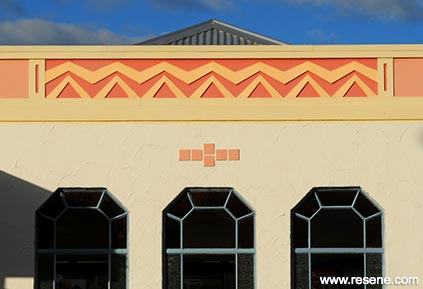From Habitat magazine - issue 11
As a champion of Napier’s Art Deco heritage, Robert McGregor has been instrumental in saving buildings and promoting eye-catching colour schemes.

Robert McGregor, a longtime champion of Napier’s Art Deco heritage.
A dazzling glamour event held every year in summer, Napier’s Art Deco Weekend is a highlight of the tourism calendar. Since the 1990s, the festive weekend has attracted thousands of people from throughout the nation and the world.
At all times of the year, visitors can walk the streets or take the daily organised tour of the district’s 140 architectural treasures built in the 1930s, painted in often vibrant colour combinations.
Robert McGregor, heritage officer for the Art Deco Trust, explains that it’s largely the strong colour schemes which have made the Art Deco buildings so popular today. Colour helps focus attention on the magnificent detail that captures the essence of the era.
“The paint colour brings up the detail so it can be read. By using colour, you draw the eye to the way the architect modelled the building and people suddenly see it in a different light.”
Resene is used not only because it is great paint, but because Robert likes the way the colours are presented graded in shades. “It makes it easy to choose paint schemes because Art Deco colours are successively layered from pale to dark.”


For many years the buildings were largely ignored. As the director of the Hawkes Bay Museum, Robert McGregor was instrumental in helping to convince Napier it had something truly unique, capable of becoming a major tourist drawcard.
He explains how it began. “In 1981, a group of planners and architects from the OECD came through Napier and were shown the four heritage buildings that had survived the 1931 earthquake. That’s how we viewed Napier at that time – a city whose heritage had almost all been destroyed... As they looked down from the hill, they pointed to the Art Deco buildings of the 1930s and said, ‘those are the real treasures, and there are so many of them.’ It had been staring us in the face all that time. But suddenly it hit home.”
Napier is also unusual for its Art Deco town centre. In other parts of the world, there was almost no building activity in the early 1930s because of the Depression.


The Art Deco Group was formed, but changing people’s perceptions of Art Deco was difficult. In the late 1980s when several important buildings came under threat, Robert and his colleagues worked tirelessly to ensure they weren’t lost.
In 1987, the group became the Art Deco Trust with Robert as its first president. A year later he received a travel grant to visit museums and historic sites in the US. After this, the first Art Deco weekend was staged and was a roaring success.
“The renewed enthusiasm for the city saw people start to repaint their old buildings, which had become shabby with age, in appropriate colours.” In 1992, the council gave the trust funding to establish premises with a paid-up manager. Robert became the executive director, and a full-time administrator was taken on. The council also introduced the Art Deco Improvement Grant Scheme, subsidising the painting of buildings with trust-approved colour schemes.
Explains Robert: “The buildings were colourful when they were built. But not like they are now because the colours were created with oxides in the cement and the buildings didn’t need to be painted... By today’s standards, the colours were quite sombre.”
But by national standards, they were quite different, in cream, ochre, buff, pink, lime green, chrome green and blue, and often with two or three colours on one building to accentuate decorative details.
As the building surfaces became grubby with age in the 1960s and 70s, they were painted, often in unsympathetic colours. The trust’s policy was to encourage a polychromatic scheme to allow shadow effects which emphasise the bas relief detail. “If people come to the trust with drab colour schemes, we simply say, ‘sorry, we don’t approve’.”
Robert recently retired from what had become a demanding role. The job has since been split in two, so Robert is back working part-time as the trust’s heritage officer.
He speaks of his passion for Art Deco. “It was a fascinating period of huge change... Everything was being thrown out and replaced. Art Deco encapsulates the exploring and embracing of the new. Its symbols are of speed, power and the new woman. It must have been incredibly exciting. We could see the potential Napier had to be a world famous city. And it’s been nothing but fun!
”Whereas other new world cities revel in earnest but boring heritage celebrations, “Napier’s festival is all about cocktails, laughter, beautiful cars and glamour – that’s what brings the city’s buildings to life.”
Art Deco originated in Europe and its heyday was from 1920 to 1940. It became widely known following the great Exposition des Arts Modernes Decoratifs et Industriels, held in Paris in 1925 and from which its name was ultimately derived. Art Deco expressed all the vigour and optimism of the roaring 1920s, and the idealism and escapism of the grim 1930s. Its decorative themes are:
For more information, visit www.artdeconapier.com.
Words: Vicki Holder
Pictures: Rossi Gannon
Search habitat magazine stories
Printed copies of habitat highlights are available from late March 2024 at Resene ColorShops and resellers, while stocks last. You can view back issues of habitat magazine online.
Specifiers:
If you have an idea, project or story that you think would suit habitat, we’d love to hear from you. Please drop us an email with your details and include photos if submitting a project.
Sign up for a DIY card and Save! Australia | New Zealand